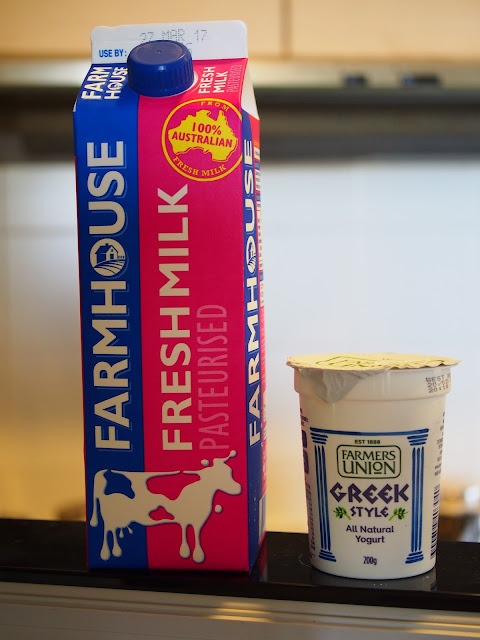Ingredients
1 litre of fresh milk (avoid skim or low fat)
2 tablespoons of milk powder (optional, but recommended for thicker constituency)
45g plain yoghurt with live active cultures
(can use any store-bought plain yoghurt to start with, subsequently you can use your own homemade yoghurt)
Tools
thermometer
jars
Method
1. Scoop out 45g of plain yoghurt and set aside at room temperature.
2. Heat up 1 litre of milk in a clean saucepan on low heat. Whisk in the milk powder, if using. Using a thermometer, heat up the milk to about between 86 to 90 degree Celsius. Whisk often to prevent the milk from scorching. This step of heating up the milk helps to sterilize the milk. Take note not to boil the milk or the necessary bacteria to make yoghurt will be killed.
3. Once it reaches the desired temperature, remove from heat. Cover and let it sit for 10mins. According to a book, this helps to produce thicker yoghurt.
4. The next step is to cool the milk to about 43 to 44 degree Celsius. You can accelerate the cooling by placing the saucepan in a large bowl of ice water and stirring constantly.
5. While the milk is cooling, prepare the jars. Rinse them in hot water to sterilize them. Set aside.
6. Once temperature has dropped to about 43 to 44 degree Celsius, we can now add the plain yoghurt. Scoop few spoonful of milk from the saucepan into the bowl of plain yoghurt. Mix well and pour back to the saucepan. Stir to mix well. Pour the milk into the sterilized jars.
7. If you have a yoghurt maker, follow the instructions. If not, you need to create a warm environment between 41 to 46 degree Celsius for fermentation. Note that temperature higher than 47.5 degree Celsius may kill most cultures. Temperature lower than 41 degree Celsius may cause the yoghurt to be slimy or not set at all.
8. I use a cooler bag, place few bottles of hot water in it and cover with hand towel . Zip up and avoid moving or shaking the jars during this incubation period which may take between 4 hours to 7 hours. Check after 4 hours to see it the yoghurt is ready. The yoghurt is ready once thickened and firm. If not ready and the bottles of hot water has cooled down, replace with new hot water. This method works well for me.
9. Once the yoghurt has set, put them in the fridge to chill and firm up. They are good up to a week.
Note : Incubating longer will make the yoghurt more tart and firm. However, if you see whey (golden liquid) on the surface, it has probably over incubated. In this case, just pour away the liquid, or stir it back in when the yoghurt has chilled.











No comments:
Post a Comment